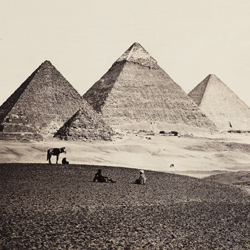Photography and Discovery
November 12, 2016–February 5, 2017

Francis Frith
The Pyramids of El-Geezeh from the South West, from Egypt, Sinai and Jerusalem: A Series of Twenty Photographic Views, c. 1860. Albumen print. Acquired by the Clark, 1998.42.3.12
Photography and Discovery
Eugene V. Thaw Gallery, Manton Research Center
Clark Art Institute, Williamstown, Massachusetts
Click here to purchase tickets
Photography and Discovery is the first extensive display to feature the Clark’s collection of nineteenth- and early twentieth-century photography. Built over the past eighteen years, the collection of primarily European, American, and British photographs now numbers more than 1,000 objects and echoes the strengths of the Institute’s holdings in painting, sculpture, decorative arts, prints, and drawings. Included as well are works on loan from the Troob Family Foundation and selections from the Clark’s David A. Hanson Collection of the History of Photomechanical Reproduction.
When photographs were first widely produced and distributed during the second half of the nineteenth century, they offered viewers new ways to discover unknown people, places, and things. The exhibition explores how photographers considered these subjects during the medium’s first seventy-five years. During this period, images were captured for many different reasons—from documentation to curiosity—and they came in many forms, including deluxe book illustrations, portable portrait cards, and frame-worthy landscape views.
Photography and Discovery presents photographs in groupings based on people, places, and things and studies the ways in which the new medium educated and enlightened a worldwide audience. From intimate family portraits to majestic views of distant lands, photographs allowed individuals to view the world in a more immediate and realistic way. In addition to considering the subjects the photographs document, the exhibition studies the techniques and artistic license employed by early photographers.
Given the increased desire for images of all types during this era of discovery, photographic processes and techniques changed frequently and rapidly to meet demands. In the mid-nineteenth century, exposure times could be more than a minute long, and the need for immobility often dictated subject matter. Technology rapidly progressed, however, and by 1900 the click of a camera made transferring an image to a negative nearly instantaneous. In today’s age of instantaneous global communication, these images allow us to look back over the past hundred years and discover a time the world was far less interconnected.
Click here to access the exhibition microsite.
This exhibition is supported by a grant from the Robert Mapplethorpe Foundation.